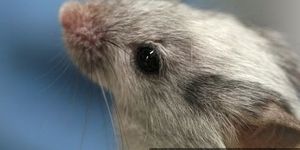Videos
Supercell Forming in Eastern Wyoming May 18, 2014
MAY 19, 2014 12:00 AM PDT
Share
Deciphered Genome Could Lead to Tsetse Fly
 After a decade-long effort a team of more than 140 scientists have deciphered the tsetse fly's (Glossina morsitans) genome, which contains 12,000 genes and 366 million letters of genetic code. The results of this effort, published in the journal Science, may lead to better ways to control this odd and sometimes deadly insect.
After a decade-long effort a team of more than 140 scientists have deciphered the tsetse fly's (Glossina morsitans) genome, which contains 12,000 genes and 366 million letters of genetic code. The results of this effort, published in the journal Science, may lead to better ways to control this odd and sometimes deadly insect.The tsetse fly is host for a parasite, Trypanosoma brucei, which is transmitted by biting, causing the victim to develop trypanosomiasis, also called sleeping sickness, which in its advanced stage targets the central nervous system, causing alteration of the biological clock, changes in personality, confusion, slurred speech, seizures and difficulty walking. Eventually those afflicted lapse into a coma and die. There are now fewer than 10,000 confirmed cases of trypanosomiasis per year, but the disease occurs in epidemics and puts 70 million people in sub-Saharan Africa at risk. As recently as 1998, there were about 300,000 cases. The illness attacks animals too. In this form it is known as nagana. Raising livestock in endemic areas is difficult or impossible, resulting in losses of billions of dollars per year.
Treatment for trypanosomiasis is long and difficult, but without it the disease is always fatal. Drugs used for treatment cause undesirable side effects and there are growing reports of drug resistance. It has not been possible to develop vaccines because of the way the parasite evades the mammalian immune system. Since tools for disease control are so limited, reducing or eliminating tsetse fly populations holds the most promise for reducing or stopping the occurrence of sleeping sickness. Greater knowledge of the fly's biology and genetics can support this effort.
Researchers looked for genes that coded for certain proteins which were then linked with the corresponding biological function, a process called annotation. "In a first phase of the project, we used computers to automatically annotate the genetic sequence of the tsetse fly and compare it with the sequences of similar species with known genomes, such as the fruit fly. The computers flagged segments of genetic material in the tsetse fly's genome known to code for proteins in other species and used this data to predict the tsetse fly's gene structure and function," said Geoffrey Attardo of Yale University, a lead author of the study.
The scientists annotated 39 neuropeptide genes and 43 receptor genes. Neuropeptides control functions such as feeding, metabolism, reproduction and behavior. They are potentially targets for new, environmentally-safe insecticides because they regulate such crucial processes. Interfering with neuropeptides proper functioning could weaken and kill flies or inhibit their reproduction, reducing the population.
Sequencing the genome of Glossina morsitans, took so long partly because of global health politics, but also because of the fly's highly unusual biology. "Tsetse biology is just freaky," said Leslie B. Vosshall, an insect neurobiologist at Rockefeller University. "This is an insect that breast-feeds its children." Unlike other insects, it gives live birth to its young instead of laying eggs, nourishes its larvae inside the uterus with a form of milk, is oddly attracted to the colors blue and black, and feeds only on blood.
While most flies lay hundreds of eggs of which only a few survive, the tsetse gives birth to a single larva with a nearly 100 percent hatch rate. This limited reproduction caused problems, because gene sequencers need the insect equivalent of twin girls to make all of the DNA they are working from uniform. Male Y chromosomes are full of "junk DNA" which lacks the codes for making proteins. With most insects getting the amount of females needed is easy. A mosquito might hatch 500 identical females after each
blood meal. But tsetses produce fewer than 10 descendants during their entire life, half of them male. So all of the sequencing, which involved scientists around the world, was done on only 15 flies.
While there is still work to do before trypanosomiasis is eliminated, the decoding of the tsetse genome is big step in that direction. "This information will be very useful to help develop new tools that could reduce or even eradicate tsetse flies," says Dr John Reeder, Director of the Special Programme for Research Training in Tropical Diseases at World Health Organization. "African sleeping sickness is understudied, and we were very pleased to help bring together so many research groups to work collaboratively with the one shared goal in sight - the elimination of this deadly disease."
You May Also Like
JAN 14, 2025
Clinical & Molecular DX
Worldwide, asthma is the most common chronic respiratory illness that affects children, particularly Puerto Rican and Bl
...
Written By:
Carmen Leitch
JAN 17, 2025
Genetics & Genomics
Genetic sequencing has gone through several advances. A major breakthrough came when scientists began breaking the billi
...
Written By:
Carmen Leitch
JAN 28, 2025
Genetics & Genomics
Transcription factors are proteins that can bind to DNA and affect the expression of genes; some are known as master reg
...
Written By:
Carmen Leitch
FEB 05, 2025
Technology
How can the field of synthetic biology help improve engineered living materials (ELMs)? This is what a recent study publ
...
Written By:
Laurence Tognetti, MSc
MAR 03, 2025
Cell & Molecular Biology
Cooperation is common in nature. While cancer cells have been known to compete with each other for resources, it seems t
...
Written By:
Carmen Leitch
MAR 12, 2025
Genetics & Genomics
Blood donation is an important way to support community health. A consistent, reliable and safe blood supply is necessar
...
Written By:
Carmen Leitch
Loading Comments...








